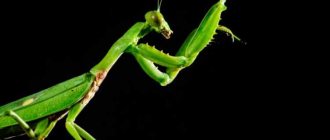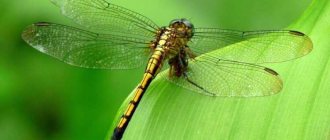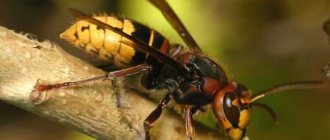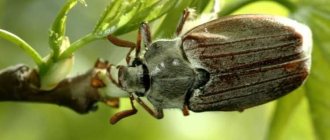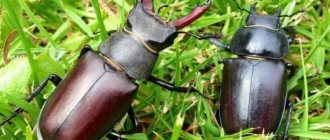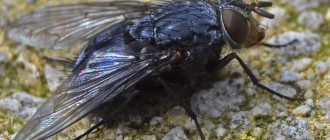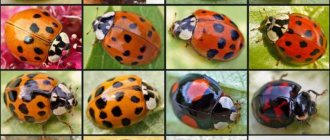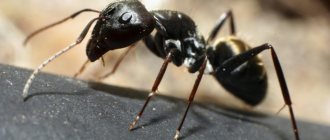- Where do hornets live?
We are surrounded by many amazing living creatures and one of them is the hornet. Our today's hero is not very loved by people, of course, because hornets are capable of attacking a person and stinging him painfully. Hornet venom can cause an allergic reaction, and in large doses (that is, with multiple stings) can even be fatal. But on the other hand, hornets are also very useful insects, including, they are simply magnificent
architects and builders, it all depends on the eyes with which we look at them. Our article today is about them.
Description, structure, characteristics
The hornet belongs to a type of arthropod insects and a subclass of winged insects, its Latin name “Vespa” can be translated as “wasp”, in fact, the hornet is the largest wasp.
The size of the hornet averages from 1.8 to 3.5 cm and the largest of them are representatives of the species Vespa mandarinia, reaching 5.5 cm in length.
Vespa mandarinia is the largest hornet in the world.
You are probably wondering what is the difference between a hornet and a wasp. Let us answer that the hornet differs from an ordinary representative of the wasp family in the larger size of its head, which has a wide crown, while part of the hornet’s head is located behind the compound eyes. In addition to them, the hornet also has 3 ordinary eyes. The color of the head can be orange, yellow, reddish-brown, even black, interspersed with yellow spots. There are antennae on the head, and what is interesting is that their number is different in females and males, and this characteristic structural feature of hornets is one of the elements of sexual difference.
The hornet's abdomen is round in shape, and also has a slender waist in the area of the articulation with the chest. In general, the colors of hornets are very similar to the colors of wasps, the difference is that the alternation of black and yellow stripes in hornets is not so bright.
Females and queens have an ovipositor at the tip of the abdomen, which at the same time is the famous sting. In its normal state it will not be possible to notice it, since the sting is retracted into the abdomen. The sting itself is straight and smooth, without serrations (like
bees) and for this reason, hornets can use it repeatedly, just like other wasps, whose sting design is very similar. There is also a special poisonous gland at the base of the sting, which makes the hornet’s bite very dangerous to humans.
The hornet also has three pairs of legs, yellow, brown or black (depending on its type). The structure of the limbs is not very simple; they consist of a coxa, trochanter, femur, tibia with a spur and the tarsus itself.
Hornets are excellent flyers, thanks to their wings, which, like many other flying insects, have as many as 4: two front and two rear. During flight, the small rear wings are attached using special hooks to the large front wings, resulting in a single flying surface.
First aid
What to do if bitten by a hornet? It all depends on where and under what circumstances it happened. It is important to protect people from mass attacks. The biological instincts of insects are aimed at survival, which means protection from external invasions. If there is a nest within 2–3 m, you must immediately leave the danger area. When indoors, you should close the windows and make sure there are no insects.
If a hornet bite occurs, the algorithm for providing first aid at home should be as follows:
- examine the wound;
- if a sting remains, for example, after hitting an insect, then carefully remove it;
- do not try to squeeze out the poison;
- suck out the contents of the wound as quickly as possible;
- treat the bite site with an alcohol wipe or liquid;
- to relieve pain and swelling, apply “cold”;
- if there are indications, then take an antiallergic drug, for example, Suprastin or Tavegil.
When treating a hornet sting at home, it is important to continue to monitor the condition of the victim. If alarming symptoms appear, you should consult a doctor.
What to do if a hornet bites a child? The algorithm of actions for providing first aid is the same as for adults. Then you need to calm the baby down, distract him from the unpleasant incident and seek the advice of a medical specialist. Incorrect assessment of symptoms, potential complications, and self-medication can significantly worsen the child’s condition.
Nest
We have already mentioned earlier that hornets are excellent builders and architects and a clear indication of their skill will, of course, be the large, multi-tiered nests built by them.
Hornets build their nests in a variety of places: in tree hollows, birdhouses abandoned by birds, in caves and attics of human buildings, on steep cliffs and hanging over tree branches. The color of the nests, as well as the shape, come in a wide variety of variations: brown, yellow, yellow-white, beige, purple; in shape they can resemble a pear, an oval or a large ball. The size of the nest can reach up to 70 cm in height and up to 40 cm in width.
Interesting fact: the process of creating hornet nests is a little similar to the process of creating paper, which is why such nests are sometimes called paper nests. The fact is that the materials used for construction are soft wood fibers and tree bark, which the hornets carefully chew and glue together with their sticky saliva. They apply a thin layer of this viscous mass onto the nest, and after hardening it turns into some kind of paper - you can even write on it with a pencil, although, of course, the quality of such “paper” will be significantly inferior to ordinary paper.
It is interesting that among the representatives of the hardworking kingdom of hornets, there are also hornets - drones and robbers. Such, for example, is the Dybovsky hornet, which does not build its own nests, but instead likes to settle in the built nests of hornets of other species, killing the local queen, taking her place and laying its eggs on worker hornets that are in the dark. This is a real palace coup in the kingdom of hornets
But some eastern species of hornets have a tendency to build underground nests with an extensive system of passages and tunnels. In some ways, such nests resemble anthills or termite mounds.
Controlling hornets and wasps in the garden
There are many ways to destroy wasp nests, but not all of them are safe. It should be remembered that insects perceive any approach to their home as extremely hostile, and the entire swarm can attack. If it is necessary to urgently get rid of a dangerous neighborhood, the only correct solution would be to treat with insecticidal agents, taking precautions. However, even if all the wasps on your site are poisoned, their nest will not be empty for long, and another colony will take it.
The best option for controlling striped predators may be to destroy their homes in the spring, when they are not yet inhabited. You need to carefully examine the buildings, old trees, old birdhouses, and burn all the nests. Repeat your rounds regularly, and if small nests appear, destroy them. Before the onset of the summer season, the wasps will build their homes in another place.
Nutrition
In terms of their feeding style, hornets are omnivorous insects, but they are still mostly vegetarians, preferring plant foods, especially if they are rich in sugar. They especially love overripe fruits: apples, pears, plums, they adore honey and nectar, which is why they often raid bee apiaries. If necessary, the hornet can turn into an excellent hunter, whose prey will be flies, grasshoppers, dragonflies, spiders,
butterflies, bees and even their closest relatives, wasps. Some particularly warlike species of tropical hornets can destroy up to 500 colonies of bees and wasps within their lifetime (not at all long)!
Interesting fact: representatives of the Vespa bicolor tropical hornet species living on Hainan Island sometimes attack orchids, mistaking them for bees by their smell.
But what is curious is that the prey killed by the hornet, which is thoroughly chewed into a suspension, is not used as food for the hornets themselves, but serves as a source of food for feeding the voracious larvae during their growth period. Sometimes hornets find dead insects for this purpose, which they also chew as food for their offspring.
What does an insect eat?
Hornets feed on nectar and plant foods containing a lot of sugar. Insect preferences include ripe fruits, berries, flower nectar, honey and tree sap.
At the same time, hornets are predators. They hunt insects to feed their larvae. With the help of its sting and powerful jaws, the hornet easily copes with flies, horseflies, gadflies, bees, wasps, grasshoppers and locusts. It completely chews the prey and feeds it to the larvae.
Reproduction
Hornets are social insects with a complex hierarchical structure and caste system. Each hornet performs its strictly defined role, depending on its caste. The division into castes: female worker hornets, males and the queen, helps the hornet kingdom organize, including their proper reproduction, nutrition, nest building, protection of their colony and many other useful and important things.
With the onset of warm days, the queen flies around the territory in search of a suitable place to build a nest where a new colony of hornets will live. When a suitable location is found, the queen begins building honeycomb cells. Then one egg is placed in one cell, from which a small larva forms after a few days. In two weeks it will turn into a pupa, which, in turn, again after two weeks will become a fully grown individual, capable of gnawing through the lid of the cell and coming out.
Types, photos and names
Here are the most popular and interesting, in our opinion, species of representatives of the hornet kingdom.
Common hornet
She is also a hornet wasp - a very large representative of the hornet family: the queen reaches a length of 2.5-3.5 cm, the males are somewhat smaller - 2.1-2.8 cm. Females and males also differ in structure: for example, males have antennae of 13 segments, in females from 12. It is interesting that only females have a sting (they use it mainly for protection), males are deprived of it. Their abdomen is colored with alternating stripes of orange-yellow and black. The common hornet lives in all European countries (including Ukraine), China, Kazakhstan, North America
Hornet is deplorable
This representative of the hornets is a full citizen of the Philippine Islands, which is where their habitat is. Unlike ordinary hornets, they are black in color. The mournful hornet is also one of the most dangerous, since this species produces a special highly toxic poison, which makes its bite especially unpleasant.
Eastern hornet
She is also an eastern wasp - another representative of the hornet family, as you guessed by the name, living mainly in the east: in Turkey, Iran, India, Pakistan, Oman, China, Nepal and some other countries. But representatives of this species are also found in southern Europe: Italy, Romania, Bulgaria, Greece. It is not without reason that he lives in these southern places; he especially loves warm and hot climates and tolerates them well. A characteristic feature of the eastern hornet is the presence on the abdomen of a wide stripe of a yellow-whitish hue. According to the observations of scientists, this very stripe contains a special pigment xenotropin, which allows insects to convert absorbed sunlight into electricity. Further research in this area could yield amazing results in the energy sector, but let's return to the hornets.
Dybovsky's Hornet
He is also a black hornet, already mentioned in our article, in connection with his predatory parasitic habits - this species rarely stands its own nests, preferring to seize others. They live in China, Thailand, Japan, India, Transbaikalia.
Giant Asian hornet
Or Vespa mandarinia has also already been mentioned in our article as the largest hornet in the world - the length of some representatives of this species exceeds 5 cm. It is also the proud owner of the longest sting (about 6 mm), which makes its bite very painful and dangerous. Lives in Asian countries: Korea, China, Nepal, India, mainly in mountainous areas.
Japanese hornet
It is actually a subspecies of the Asian giant hornet native to Japan, where it is also called the “sparrow bee.” It is also a very large representative, its body length often exceeds 4 cm. It is also very dangerous; due to the presence of nerve toxins in the venom, its bite can be fatal; in Japan, about 40 people die every year due to the bite of this insect.
Habitat
These insects are very widespread throughout the world, if we talk about middle and temperate latitudes. The common hornet is found everywhere in the central and southern regions of Europe, including CIS countries such as Ukraine, Russia, and Belarus. There are also plenty of them in Asia and North Africa.
Asian countries can be considered the homeland of these striped beauties, since the climatic conditions of countries such as China, India, Korea and Japan can be considered ideal for the life and reproduction of all types of wasps and hornets.
What to do if bitten by a hornet
If you have been bitten by a hornet, you must immediately take the following measures:
Consequences
- children;
- elderly and senile people;
- patients with a history of allergies, chronic diseases of the heart, blood vessels, and respiratory organs.
The severity of symptoms and the possibility of developing complications depends on the health status of the victim.
If there was no allergic reaction of the body, then the inflammation caused by the hornet sting goes away in a few days. This can be judged by the reduction in swelling, redness, and pain in the wound area.
The damaged area may itch for some time. How to relieve itching after a hornet bite? It is enough to apply cold. If this is one of the symptoms of an allergic reaction, then you should consult a doctor who will prescribe antihistamines.
How to get rid of hornets
Hornets, despite the danger posed by them, also bring benefits, for example, they destroy various harmful insects, all kinds of garden and vegetable pests. But still, there is no place for them to live next door to a person. And the hornets themselves do not often appear near human dwellings; they are usually attracted here by sweet aromas: the smell of honey or overripe fruits.
If a hornet accidentally flew into your window, do not try to drive it out by furiously waving a rag or other object, it may well sting you. It’s better to wait until it calms down and sits down like some kind of surface and quickly cover it with a simple glass jar. Then carefully release the hornet outside.
Treatment
In the International Classification of Diseases, Tenth Revision ICD-10, a hornet sting is designated by code W57 - stinging by non-venomous insects and arthropods.
There is no specific antidote for a hornet sting. Therefore, treatment includes the use of the following drugs:
- analgesic;
- antihistamine;
- antipyretic;
- decongestant.
If life-threatening complications develop, intensive therapy is carried out in the intensive care unit.
If a hornet bites you on the head, namely, in the area of the face or neck, swelling may develop that affects the airways. This condition threatens the life of the victim and requires treatment in a hospital. Airway obstruction is an indication for hospitalization in the intensive care unit. Intensive therapy includes the administration of glucocorticosteroids (hormones of the adrenal cortex), diuretics, and, if necessary, connection to a ventilator.
Video
And finally, we bring to your attention a film about our heroes, under the menacing title “Hornets - an empire of ruthless killers.”
Author: Pavel Chaika, editor-in-chief of Poznavaika magazine
When writing the article, I tried to make it as interesting, useful and high-quality as possible. I would be grateful for any feedback and constructive criticism in the form of comments on the article. You can also write your wish/question/suggestion to my email [email protected] or Facebook, with respect, the author.
Author page


